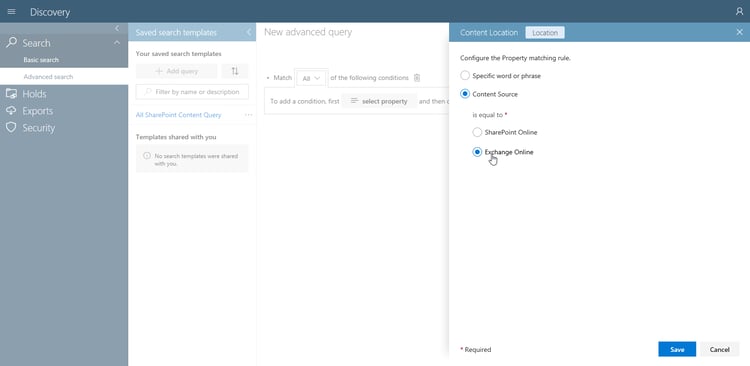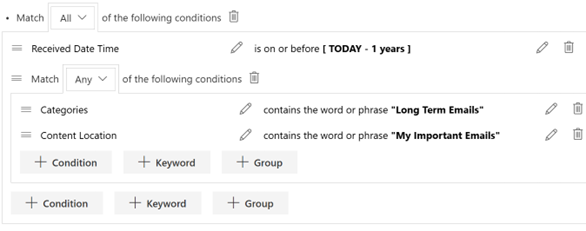Whether you’re fulfilling an FOI request or just needing to find a specific contract from that old deal, it’s important that you can properly search and discover the content that you’re looking for. Microsoft SharePoint has some solid search capabilities that can be taken advantage of which will be covered in this post. But what about when you need to go deeper: say, find a scanned PDF file or identify all relevant content from multiple repositories for a Legal Hold? We will also look at how you can use a cloud-based tool to step beyond what is available in SharePoint to simplify your content search and discovery with capabilities that save time and frustration.
Search with Microsoft SharePoint Out-Of-The-Box
SharePoint allows you to search through contacts, documents, files, folders, lists, libraries, and sites on the platform. This can be done using the global search boxes which let you select from the sections: Everything, People, Conversations, and This Site. Or, if you know which document library your content is stored in, you can look from that specific document library search box. This search is simple, straightforward, and extends across the sites and sub-sites to look in document text and metadata (file name, title, author, keywords, and category systems).
However, typing in a general keyword or two in the site search box may bring up too many irrelevant results since the scope is usually the whole site collection. An advanced search option is available for more detailed queries, but steps need to be taken to make this available on your preferred SP page.

Figure 1: SharePoint search box: can look up files, sites, contacts, and news based on keyword search.

Figure 2: SharePoint document library search box.
In addition, there are instances that the content you are searching for is not an MS Office document or readable PDF, has not been properly titled/labeled for search, or perhaps is not even stored in SharePoint (remember that email attachment you completely forgot to save to the appropriate SP folder?).
Faster, More Specific Search Across Platforms
So while Microsoft SharePoint does have the pros of straightforward search that is out-of-the-box for your basic needs, there are limitations with sifting through all the site results and with the types of content that you can discover. To step beyond this, storing your content in the Collabspace data lake allows you to save time with deep and precise search, and provides the ability to conduct search content across multiple repositories.
How? Content from multiple sources (SharePoint, Microsoft Exchange, File Shares, etc.) is streamed into the Collabspace data lake. By going into the Search Page, you can search across these platforms from one spot to see all versions of your backed up content. Collabspace enterprise-wide, unified search allows you to save time with advanced filtering and query conditions so that you get more precise results. And lastly, keyword search does not only cover file names, metadata, and content within typed documents and readable PDFs- but you can search by location and use Optical Character Recognition (OCR) to find files such as TIF images and scanned PDFs.
Figure 3: Collabspace search page allows you to search across multiple platforms from one place (SharePoint Online and Exchange Online shown, but other sources such as OneDrive and File Shares are also available).
Simplified Content Discovery to Streamline Business Processes
These powerful capabilities save time in search, and make discovery of relevant information simple for business processes such as E-Discovery, FOI requests, and GDPR. As a use case example, when identifying relevant content to place on Legal Hold during a litigation case, users can use out-of-the-box to look and find all potential content relevant to that case. This would require searching through SharePoint, File Shares, Microsoft Exchange, etc. before placing the hold, and then sending all held content to lawyers.
Using Collabspace, those assigned to placing the Hold can search across all platforms of the backed up content from the Collabspace Search Page rather than in each source, place a transparent Legal Hold on single, multiple, or all result items, and then filter through those results to easily exempt non-relevant items before exporting it to the lawyers. This not only streamlines the process, but saves organization dollars that would have been spent on legal fees for the lawyers to identify and go through all potentially relevant data themselves. 
Figure 4: In Collabspace, time and dollars are saved during E-Discovery with advanced search and ability to put items on Hold.
While both SharePoint out-of-the-box and Collabspace search both bring something to the table, storing and searching content in a Collabspace data lake repository can save time and simplify business processes with cross-platform, precise search and OCR capabilities. To find out more and see a live demonstration of how the Collabspace data lake can be used to boost your eDiscovery, you can access our on demand webinar below:
Curious to read more? Check out our blogs on the Data Lake and Legal Holds.






